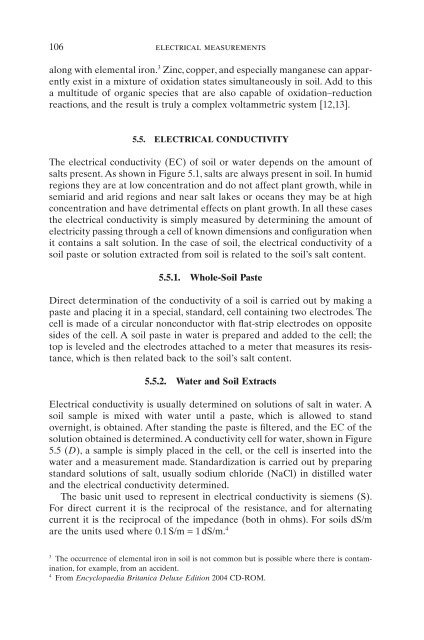Introduction to Soil Chemistry
Introduction to Soil Chemistry
Introduction to Soil Chemistry
Create successful ePaper yourself
Turn your PDF publications into a flip-book with our unique Google optimized e-Paper software.
106 electrical measurements<br />
along with elemental iron. 3 Zinc, copper, and especially manganese can apparently<br />
exist in a mixture of oxidation states simultaneously in soil. Add <strong>to</strong> this<br />
a multitude of organic species that are also capable of oxidation–reduction<br />
reactions, and the result is truly a complex voltammetric system [12,13].<br />
5.5. ELECTRICAL CONDUCTIVITY<br />
The electrical conductivity (EC) of soil or water depends on the amount of<br />
salts present. As shown in Figure 5.1, salts are always present in soil. In humid<br />
regions they are at low concentration and do not affect plant growth, while in<br />
semiarid and arid regions and near salt lakes or oceans they may be at high<br />
concentration and have detrimental effects on plant growth. In all these cases<br />
the electrical conductivity is simply measured by determining the amount of<br />
electricity passing through a cell of known dimensions and configuration when<br />
it contains a salt solution. In the case of soil, the electrical conductivity of a<br />
soil paste or solution extracted from soil is related <strong>to</strong> the soil’s salt content.<br />
5.5.1. Whole-<strong>Soil</strong> Paste<br />
Direct determination of the conductivity of a soil is carried out by making a<br />
paste and placing it in a special, standard, cell containing two electrodes. The<br />
cell is made of a circular nonconduc<strong>to</strong>r with flat-strip electrodes on opposite<br />
sides of the cell. A soil paste in water is prepared and added <strong>to</strong> the cell; the<br />
<strong>to</strong>p is leveled and the electrodes attached <strong>to</strong> a meter that measures its resistance,<br />
which is then related back <strong>to</strong> the soil’s salt content.<br />
5.5.2. Water and <strong>Soil</strong> Extracts<br />
Electrical conductivity is usually determined on solutions of salt in water. A<br />
soil sample is mixed with water until a paste, which is allowed <strong>to</strong> stand<br />
overnight, is obtained. After standing the paste is filtered, and the EC of the<br />
solution obtained is determined.A conductivity cell for water, shown in Figure<br />
5.5 (D), a sample is simply placed in the cell, or the cell is inserted in<strong>to</strong> the<br />
water and a measurement made. Standardization is carried out by preparing<br />
standard solutions of salt, usually sodium chloride (NaCl) in distilled water<br />
and the electrical conductivity determined.<br />
The basic unit used <strong>to</strong> represent in electrical conductivity is siemens (S).<br />
For direct current it is the reciprocal of the resistance, and for alternating<br />
current it is the reciprocal of the impedance (both in ohms). For soils dS/m<br />
are the units used where 0.1S/m = 1dS/m. 4<br />
3<br />
The occurrence of elemental iron in soil is not common but is possible where there is contamination,<br />
for example, from an accident.<br />
4<br />
From Encyclopaedia Britanica Deluxe Edition 2004 CD-ROM.
















